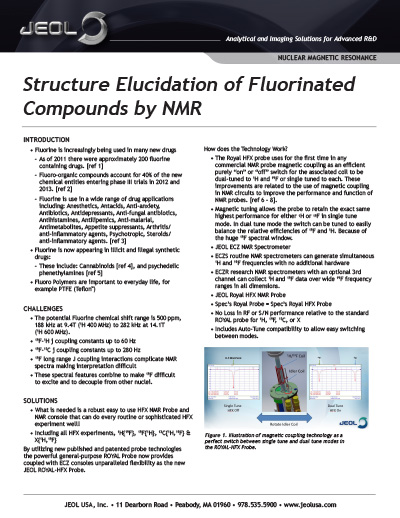JEOL Resources

Documentation in support of your JEOL product.

Structure Elucidation of Fluorinated Compounds by NMR
Introduction
- Fluorine is increasingly being used in many new drugs
- As of 2011 there were approximately 200 fluorine containing drugs. [ref 1]
- Fluoro-organic compounds account for 40% of the new chemical entities entering phase III trials in 2012 and 2013. [ref 2]
- Fluorine is use in a wide range of drug applications including: Anesthetics, Antacids, Anti-anxiety, Antibiotics, Antidepressants, Anti-fungal antibiotics, Antihistamines, Antilipemics, Anti-malarial, Antimetabolites, Appetite suppressants, Arthritis/anti-inflammatory agents, Psychotropic, Steroids/anti-inflammatory agents. [ref 3]
- Fluorine is now appearing in illicit and illegal synthetic drugs:
- These include: Cannabinoids [ref 4], and psychedelic phenethylamines [ref 5]
- Fluoro Polymers are important to everyday life, for example PTFE (Teflon™)
Challenges
- The potential Fluorine chemical shift range is 500 ppm, 188 kHz at 9.4T (1H 400 MHz) to 282 kHz at 14.1T (1H 600 MHz).
- 19F-1H j coupling constants up to 60 Hz
- 19F-13C j coupling constants up to 280 Hz
- 19F long range J coupling interactions complicate NMR spectra making interpretation difficult
- These spectral features combine to make 19F difficult to excite and to decouple from other nuclei.